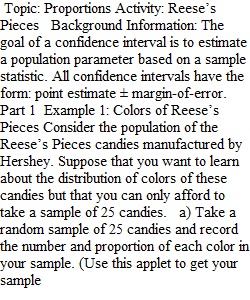


Q Topic: Proportions Activity: Reese’s Pieces Background Information: The goal of a confidence interval is to estimate a population parameter based on a sample statistic. All confidence intervals have the form: point estimate ± margin-of-error. Part 1 Example 1: Colors of Reese’s Pieces Consider the population of the Reese’s Pieces candies manufactured by Hershey. Suppose that you want to learn about the distribution of colors of these candies but that you can only afford to take a sample of 25 candies. a) Take a random sample of 25 candies and record the number and proportion of each color in your sample. (Use this applet to get your sample http://www.rossmanchance.com/applets/OneProp/OneProp.htm?candy=1) b) Is the proportion of orange candies among the 25 that you selected a parameter or a statistic? c) Is the proportion of orange candies manufactured by Hershey’s process a parameter or a statistic? What symbol represents it? d) Do you know the value of the proportion of orange candies manufactured by Hershey? e) Do you know the value of the proportion of orange candies among the 25 that you selected? f) Do you suspect that every student in the class obtained the same proportion of orange candies in his/her sample? Part 2 Class data from Part 1 of the Reese’s Pieces Lab. g) Create a dot plot for the sample proportions of orange candies collected – refer to the data I provided you. h) Did everyone obtain the same number of orange candies in their samples? What was the minimum number of orange candies collected? What was the maximum number of orange candies selected? i) Based on what you have learned about random sampling and having the benefit of seeing the sample results of the entire class, take a guess concerning the population proportion of orange candies. Is this the same as the proportion of orange candies from your original sample? Why or why not? j) Create a 95% confidence interval for the population proportion of orange candies using the process we discussed in class. Point estimate: p ? from the class data Critical z value: Standard error: Margin of Error: Lower Bound: Upper Bound: Interpretation: k) Did your guess in part i) fall between your lower and upper bounds above? l) In what way would the dotplot have looked different if each student had taken a sample of 10 candies instead of 25? (If unsure, you can check this using the Reese’s Pieces applet http://www.rossmanchance.com/applets/OneProp/OneProp.htm?candy=1) m) In what way would the dotplot have looked different if each student had taken a sample of 75 candies instead of 25?
View Related Questions